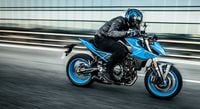According to Alta, the 2017 Redshift MX never had a range problem: The issue was heat. Electric vehicles strive to maximize the energy transfer rate from the battery to the motor. The faster the rate, the quicker the motor can spin, the faster the vehicle can go, and the more heat the system will produce. If any one of the many temperature sending units monitoring the dozens of individual 18650-size cells within the bike's battery pack sensed temperatures over 150 degrees Fahrenheit, the machine automatically limited power to prevent long-term damage. For riders who grew up ripping around tracks on internal combustion power, it felt like a machine on its way to dead.
Alta says this happened in very specific situations. Both the 2017 Redshift MX and the 2018 Redshift MXR feature four throttle maps. The fourth, Overclocked, is the most aggressive, offering the highest-possible energy-transfer rate. On loose or muddy tracks with either a hardcore racer or a throttle-happy amateur behind the bars, the battery on the outgoing 2017 model could quickly reach that 150-degree threshold.
The solution came in the form of some cleverness. The 2018 Redshift MXR and EXR use Alta’s updated R5.8 battery pack with a unique battery chemistry designed to yield maximum energy release over longer periods at lower temperatures. The company won’t say what’s in the mix or exactly what it changed compared to the 2017 pack. Alta claims that information—and even the identity of the manufacturer of those cells—is proprietary. But with new software and an upgraded high-voltage chain, including all the wiring strung from the battery to the inverter and on to the motor itself, the 2018 Redshift MXR produces 50 horsepower and 42 pound-feet of torque. That’s 10 better than the old bike, all while using an identical motor.
/cloudfront-us-east-1.images.arcpublishing.com/octane/KUIWGKWHGJWBUP5VJTZQED5ZNQ.jpg)
/cloudfront-us-east-1.images.arcpublishing.com/octane/7OWQWAWJBFCGTAYQWBMWGNMNB4.jpg)
/cloudfront-us-east-1.images.arcpublishing.com/octane/4G5XKCDIHRCGRHVF7OPORG7ZX4.jpg)
/cloudfront-us-east-1.images.arcpublishing.com/octane/D2BDYKKNZ5GRHGDMI4PZTGRMME.jpg)

/cloudfront-us-east-1.images.arcpublishing.com/octane/UAY4WSZPOFDQRP4MCEXAKDFQOQ.jpg)

/cloudfront-us-east-1.images.arcpublishing.com/octane/X5CE3KSJHZHM5CUFGPZ7U26WB4.jpg)
/cloudfront-us-east-1.images.arcpublishing.com/octane/COWLTPGFAFGDDGJCTENYMA4VJM.jpg)
/cloudfront-us-east-1.images.arcpublishing.com/octane/H3PKUGPSUJFTND4RFPSI4OIDCE.jpg)
/cloudfront-us-east-1.images.arcpublishing.com/octane/UHGQA3MQDFCA3HLBWF7S76WH6Y.jpg)
/cloudfront-us-east-1.images.arcpublishing.com/octane/Q5EORCSTNFAVBJC4IYUHIKJTXQ.jpg)
/cloudfront-us-east-1.images.arcpublishing.com/octane/XIJ5FUFSP5A3NL7MOVZGJXAHC4.jpg)
/cloudfront-us-east-1.images.arcpublishing.com/octane/V5NZN3CGS5B5PPYFYJHIPAU5S4.jpg)
/cloudfront-us-east-1.images.arcpublishing.com/octane/CZE6ONOBU5E7HPIEEADU376C4M.jpg)
/cloudfront-us-east-1.images.arcpublishing.com/octane/UT4KL3SIYJBSPNHWJXTBE6MTGE.jpg)
/cloudfront-us-east-1.images.arcpublishing.com/octane/Q3UOIDZ22ZEVDBZUWGJXIMGJKI.jpg)
/cloudfront-us-east-1.images.arcpublishing.com/octane/YQM66WXZV5AAXNNOIUVOGVXZMY.jpg)
/cloudfront-us-east-1.images.arcpublishing.com/octane/J47NFTXNLFFGHELHZCUD2LCITA.jpg)
/cloudfront-us-east-1.images.arcpublishing.com/octane/NXPQBTLX3NCILKQ2GCFJYNIDEM.jpg)
/cloudfront-us-east-1.images.arcpublishing.com/octane/6U7NJLAYMRBZTIGNKWIA5OK2FQ.jpg)
/cloudfront-us-east-1.images.arcpublishing.com/octane/IYTZQWUROVC25IMTDEWUDQ5IQE.jpg)
/cloudfront-us-east-1.images.arcpublishing.com/octane/YJODDXEL2ZB5TENKPPN4BEYJAE.jpg)
/cloudfront-us-east-1.images.arcpublishing.com/octane/QEQQUZYNJFAIJB4DZFVFSNTCQ4.jpg)
/cloudfront-us-east-1.images.arcpublishing.com/octane/F4EEHDT3UZFKPLKVGDWMMPFEQE.jpg)